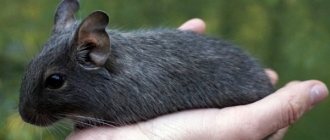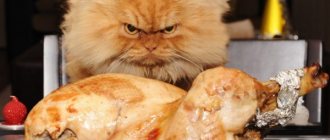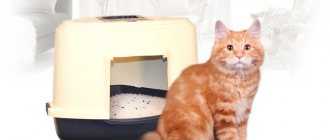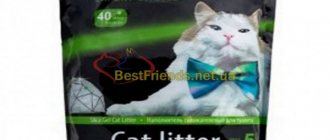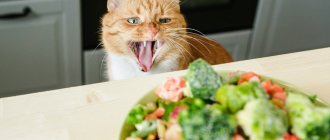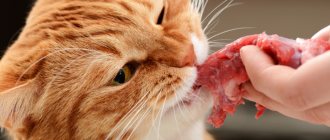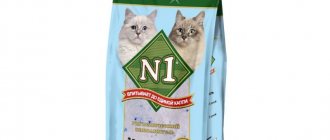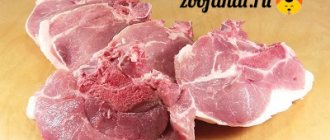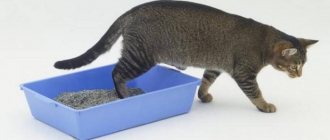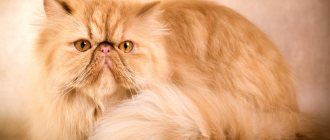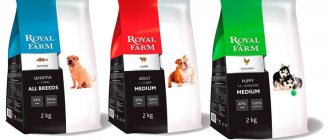Every owner needs to know where to buy and how to choose a cat milk substitute.
After all, sometimes situations arise when a cat, for some reason, is not able to feed kittens.
Cats are very gentle creatures. Newborn kittens should start eating immediately after birth.
That is why the female’s body begins to produce cat milk in advance, before the onset of childbirth.
Maternal colostrum has unique immunomodulatory properties
Sometimes situations arise when a cat, for some reason, is unable or refuses to feed kittens.
Either the animal dies after childbirth or even during its process.
Therefore, every responsible cat owner needs to know what can replace cat milk if necessary.
The first meal of the day for kittens is vital because, together with their mother’s milk (which at first faintly resembles milk and is called colostrum), they receive a portion of antibodies to deadly viruses.
Thus, within 24 hours, babies receive lasting immunity.
It is important to understand that colostrum is unique in composition and cannot be replaced artificially.
Cat milk replacers are intended to be an alternative to milk in the classical sense, which the cat lactates with after colostrum.
Features of cat milk
Cat's milk contains certain vitamins, minerals, and specific antibodies that provide the baby's body with valuable nutrients and form its immune system. For this reason, in cases where a kitten requires artificial feeding, the optimal solution for caring owners is to purchase high-quality cat milk substitutes.
What are the properties of this product, and how to use it correctly? In order to correctly select a high-quality substitute, you need to have information about what is contained in natural cat milk, and how it fundamentally differs from the usual goat or cow milk.
First of all, it should be noted that cat colostrum is not fatty, since it consists of almost 70% water.
In terms of lactose and protein content, cat's milk is significantly superior not only to cow's milk, but even to female colostrum.
What are substitutes and their composition
For artificial feeding of kittens, companies producing ready-made diets have released a special line of products called “cat milk replacers.” This product is most similar in composition to cat colostrum and includes the following elements:
- taurine (amino acid);
- complex of vitamin and mineral components;
- fatty acids (omega-3 and omega-6).
It is extremely important for owners to monitor the ratio and proportions of the ingredients contained in the substitute in this product. A deficiency of certain components, in particular omega fatty acids, can cause the development of serious pathologies in a kitten.
Substitutes are sold in dry, powder form, and are also available in liquid form. It is believed that the liquid product is more useful and is better absorbed. However, it should be remembered that its shelf life is much shorter than that of the substitute in dry form.
Storage rules
An open package of dry mixture can be stored for 1 month. It should be placed in a dry, cool and dark place, but not in the refrigerator. The mixture is contraindicated in cold and humidity.
The finished product must be kept in the refrigerator for no longer than 24 hours. Some mixtures are stored for even less - 8 hours. After the expiration date, such food should be thrown away: it becomes dangerous to drink.
The bottle, measuring spoon and nipples must be thoroughly washed after each feeding.
Important! Hands should be washed before and after feeding each kitten. The life and health of babies depends on compliance with storage conditions and hygiene rules.
Ready milk should be stored in the refrigerator for no longer than a day.
A good kitten formula will help feed orphaned pets and give them everything they need for healthy growth and development. The cat’s entire future life and health depends on the cat’s milk substitute.
In what cases is a substitute required?
Cat milk substitutes may be required if a nursing cat dies or the baby is weaned from the mother's breast. It is also impossible to do without this product if your cat has the following problems:
- mastitis;
- C-section;
- lack of colostrum or insufficient quantity.
Colostrum can be purchased on the market or in specialized factories, but this is quite difficult, expensive and not always available. In such situations, an excellent solution is a cat's milk substitute, which you can buy in specialized stores or prepare yourself at home.
GimCat Cat-Milk Powdered milk for kittens in packages: 200 g
Ingredients: Milk and dairy products (63.7%), oils and fats (including arachidonic acid - 0.21%), products of plant origin, milk sugar derivative with TGOS (1%), minerals. Additives per 1 kg: vitamin A - 20000 IU, vitamin D3 - 2000 IU, vitamin E - 100 mg, vitamin B1 - 10 mg, vitamin B2 - 10 mg, vitamin B6 - 8 mg, vitamin B12 - 60 mcg, vitamin K3 - 0.2 mg, biotin - 200 mcg, folic acid - 2 mg, nicotinic acid - 80 mg, pantothenic acid - 20 mg, calcium pantothenate - 20 mg, vitamin C - 100 mg, taurine - 1000 mg, choline chloride - 2500 mg , L-carnitine - 400 mg, copper - 5 mg, iron - 90 mg, zinc - 50 mg, iodine - 1 mg, manganese - 5 mg, selenium - 0.1 mg.+ Analysis: Protein - 35%, fat - 27%, ash - 6%, fiber - 0.1%, moisture - 6%, calcium - 0.9%, phosphorus - 0.5%, sodium - 0.4%.
595 RUB – prices at which GimCat Cat-Milk Powdered milk for kittens can be purchased in 200g packages.
Options:
- Age - for a kitten or nursing cat.
- Purpose
To quickly order Gimpet in the online pet store ANYzoo.RU, the “buy in 1 click” function is provided. Additional consultations by phone
This description is not a public offer. Check the expiration date with the operator.
How to choose a cat milk replacer
There is a fairly wide selection of cat milk substitutes on the modern market. How not to make a mistake and purchase a truly high-quality product? Veterinary experts recommend giving preference to trusted manufacturers who have earned a good reputation and positive reviews. These include the following brands:
- Royal Canin.
- Nutri-Vet.
- Dolphos.
- Gimpet.
- Trixie.
The cost of the product should not be too low, although, of course, an inflated price is also not a guarantee of quality.
In addition, when choosing complementary foods, experts advise taking into account the following factors:
- Kitten breed. Kittens of different breeds have specific characteristics regarding the substances necessary for their full development, which must be supplied with food. You can get detailed advice from a veterinarian, breeder, or read all about your pet’s breed.
- The composition of the substitute, in addition to lactose, proteins and fats, must include a vitamin-mineral complex, amino acids, microelements and fatty acids.
- The fat content of the product must be at least 8.5%.
- Products containing starch and artificial substances are contraindicated, as this can cause the development of allergic reactions in the kitten or provoke disorders of the digestive system.
A high-quality cat's milk substitute must be homogeneous, have a pure and extremely natural composition.
Among the various cat milk substitutes presented on the modern market, veterinarians especially highlight brands such as Beafar, Royal Canin, Gimpet, noting that these products contain the optimal amount of proteins, lactose, omega acids, vitamins and minerals, essential amino acids proportions.
Making cat milk replacer at home
If desired, owners can prepare a cat's milk substitute themselves. This task requires time and certain skills, but the resulting product will be 100% natural, high quality and affordable, compared to store-bought counterparts. There are several most common, budget-friendly and easy-to-follow recipes:
- Recipe with cow's milk . To prepare the substitute, you will need about half a liter of high-quality, high-fat cow's milk. It is recommended to warm the milk a little, after which 4 tbsp should be added to it. sugar and egg yolk, mix thoroughly. To make the product more useful, you can add special vitamin complexes for kittens in the form of drops, which can be purchased at any veterinary pharmacy.
- Recipe with milk and glucose . This type of substitute is ideal for weak, premature and sick babies. To prepare this recipe you will need to combine glucose (20 ml), cow's milk (100 ml), vitamin supplements (0.3 ml). It is recommended to add an egg yolk and a tablespoon of sunflower oil to the finished product.
- Recipe with condensed milk . The basis of the substitute is high-quality milk (condensed) without sugar, which must be mixed with bone meal, maintaining a 1:1 ratio. This product is easily digestible and is suitable for feeding even newborn kittens.
- Recipe based on baby food. Often baby food is used to feed kittens. The “Malyutka” mixture has proven itself to be excellent and will need to be diluted with water according to the attached instructions.
Before choosing the best recipe, it is strongly recommended to consult with a veterinarian, who will help you choose the best option based on the breed, body weight and age of the kitten.
Recipes for making your own mixture
If the kitten tolerates pasteurized cow's milk well, then you can make him dishes based on it. To prepare the classic recipe you will need:
- a glass of warm milk;
- 2 chicken egg yolks;
- vegetable oil - 1 teaspoon;
- 1 drop of multivitamin solution (for example, Trivita or Tetravita).
If the kitten is very weak and thin, you can prepare a sweet mixture based on condensed milk - it contains enough fats and carbohydrates so that the baby quickly gains weight and gets stronger. It is made according to the following recipe:
- Condensed milk is mixed with water in a ratio of 1:5.
- Add bone meal at the rate of 1 teaspoon per liter of liquid.
This dish is only allowed to be given to kittens over 1 week old. Suitable only for emergency feeding (after 5–7 days you should switch to a regular formula with milk or a powder substitute).
Video: how to make a mixture for kittens
This is interesting: What kind of soap for fleas for cats
How to calculate dosage
When using cat milk substitutes, it is extremely important not only to choose a quality product, but also to correctly calculate the correct dosage. When determining the amount of complementary foods, it is necessary to take into account factors such as the age category and breed of the small pet.
An approximate dosage calculation is based on the baby’s age and is as follows:
| Kitten age | Required amount of mixture |
| 1-4 days | From 30 to 32 ml |
| 5 days – 2 weeks | From 37 to 39 ml |
| From 15 to 25 days | from 44 to 47 ml |
| 26-36 days | From 52 to 55 ml |
In this case, it is worth paying attention to the breed of the animal. Large kittens require a slightly larger amount of complementary feeding than pets of small breeds. However, these data are relative.
A caring owner should monitor the condition and behavior of the kitten very carefully in order to determine the optimal amount of milk replacer. For example, an underfed baby behaves anxiously and restlessly.
Overfeeding is no less dangerous for a kitten. Observing the kitten's stool will help determine the amount of food. So, with regular overeating, it becomes gray or green; slight overfeeding is manifested by yellowish feces.
Nutrition of newborn kittens without cat feeding
Depending on the characteristics of the cat’s body, feeding kittens lasts from 40 to 60 days.
At the beginning of life, the baby eats only mother's milk and feeding it does not present any problems. This period lasts several weeks. The first portions of a cat's milk are colostrum, which contains all the useful substances to protect the kitten from various, mainly infectious, diseases, that is, for antibacterial protection. With colostrum, a newborn kitten receives antibodies, and the largest amount is absorbed during the first 6 hours of life. Later, the mucous membrane of the stomach and intestines does not allow antibodies to enter the body. The mother cat's body begins to produce milk, rich in proteins, fats, vitamins and minerals. So, 1 liter of cat milk contains 70 g of protein.
During the first 8 days of life, the kitten's body weight doubles.
For comparison, a human child doubles its weight in 5-6 months, a foal in 60 days, and a calf in 47. The kitten suckles from its mother only 3 hours a day, and the rest of the time it grows. In order to determine whether a kitten is full or not, pay attention to its behavior: well-fed cubs sleep calmly or suckle the cat, while hungry ones squeak, crawl around their mother or suck the finger extended to them. In this case, you need to feed the kittens. Babies left without a mother will also need feeding.
To replace cat milk, you can use one of several recipes:
How to use it correctly
Milk substitutes should be given to newborn babies who do not yet know how to drink on their own using a bottle with a baby pacifier; in extreme cases, a disposable syringe without a needle will also be suitable for these purposes.
Before starting feeding, the mixture must be heated to a temperature of about 38–39°C.
It is recommended to store the prepared substitute in the refrigerator. The optimal storage period is no more than a day. To properly prepare cat milk replacer purchased in stores and veterinary pharmacies, you should pay special attention to the following recommendations from experts:
- The kitten's body is very susceptible to various types of pathogens. Therefore, it is important to use sterile containers for preparing complementary foods and feeding them. Before feeding, you should wash your hands thoroughly.
- It is recommended to avoid purchasing large packages of formula, although they may seem more economical. The fact is that during long-term storage, bacteria and microbes that are dangerous to the health of the baby can penetrate into the product.
- You should avoid feeding your animal from a spoon. Such experiments often end in the death of the kitten, because the baby can choke on the mixture. In addition, the food can enter the lungs and lead to the development of pneumonia.
- The dosage of food should be increased very carefully and gradually, taking into account the age norms of the kitten. In this case, you should carefully monitor the behavior, condition and stool of your pet to avoid overfeeding or malnutrition.
- The mixtures should be diluted exclusively with clean and warm boiled water in the ratio indicated on the package.
The mixture should be prepared according to the recommendations indicated on the packaging of the finished cat milk replacer of one or another brand.
Methods and rules for feeding kittens
In any of the above cases, you will need a bottle and nipple (some manufacturers of ready-made cat milk put the bottle and nipple inside a jar of dry formula). They can also be purchased at veterinary pharmacies. You can use a plastic eye dropper or syringe (without a needle). The main requirement is sterility. Bottles and teats should be cleaned and boiled regularly. The food supply is prepared for no more than 24 hours and stored in the refrigerator. The food must be heated to 38 °C, and when giving it, you must ensure that the kitten sucks milk itself. Milk should not be introduced by force, as the baby may choke. When a kitten falls asleep or has milk bubbles coming out of its mouth, it means it is already full. It is important that kittens suckle themselves through the narrow holes in the nipple and prepare themselves for the “drinking work”. Do not give milk through a wide opening. This often leads to milk entering the respiratory tract and causing pneumonia.
- Nutrition of newborn kittens
- Nutrition of newborn kittens
- Nutrition of newborn kittens
It is better to feed kittens by holding them. They, like babies, need to be held in an upright position after feeding so that they can burp, releasing excess air. In the first 2 days of life, it is enough for kittens to give 1 teaspoon of milk every 2 hours. The dose should increase as the animals grow. It is advisable to weigh the kittens every day and keep records. If they aren't gaining weight, that should be a red flag. In the first 3 weeks of life, the kitten should be given 1 teaspoon of artificial food 7-8 times a day (every 2-3 hours, and at night too), with a night break of 5-6 hours. Gradually, the number of feedings should be reduced, increasing the amount of food fed at a time. At the age of 15-20 days, teeth begin to cut and the cat does not have the required amount of milk. From this period, kittens need to be fed, gradually transferring them to regular food. The first feeding includes dairy products (for kittens that have been fed by their mother). You should start with 2 teaspoons of milk, dry, medium fat, diluting it with warm water and adding honey or a pinch of sugar (10 g/l). Gradually, every day you need to increase the amount of milk by 1 spoon. You can also give milk porridge prepared in the same way as for baby food, or as in the example with oatmeal: it is diluted with whole milk with the addition of cream and a chicken egg (all this must be mixed into a homogeneous mass). Dairy products are given from a bowl or from a spoon, and then from a bowl. If your kitten can't figure out how to lap milk, lubricate its mouth with a drop of milk. Your little pet will understand what's going on and will begin to lap from the bowl, and soon, obeying the feeling of hunger, he will eat from the bowl himself. At about the same time, at 3-4 weeks of age, you can gradually feed kittens (both “natural” and “artificial”) with other products or soak a few granules of dry food first in warm milk and then in water. This will depend on the type of feeding you prefer for your pet: natural feeding or feeding commercially prepared food. This must be done at the same time of day. After the first 2 weeks of feeding, you can gradually diversify the menu: 2 times a week, add egg yolk and dry yeast to the milk, give porridge from chicken or fish with rice water, finely chopped or ground beef (lean); cottage cheese and entrails. If the baby has loose stools, regular milk should be replaced with concentrated milk, diluted with warm boiled water in a ratio of 1:2. At the age of 3-5 months, kittens are weaned from their mother and eat baby food until they are one year old. If you have purchased a kitten, be sure to ask the cat’s owner what kind of food he gave to the animals.
How to feed a newborn kitten
Sometimes, during weaning, kittens may develop digestive problems. In this case, add a few teaspoons of warm chamomile tea to the sick animal's milk or inject it into the cheek using a syringe without a needle. You can also introduce drugs with bifidobacteria.
The feeding regimen for different types of feeding is approximately the same.
Up to 3 months, feed your little pet 6 times a day, from 3 to 5 months - 4-5, from 5 to 9 months - 3-4, from 9 to 12 months - 1-2 times a day.
It is important that the food is warm. Kitten food is high in calories, high in protein and other nutrients. Thus, kittens up to 8 weeks of age require 628 J of energy per day, at the age of 3 months - 837 J, 4 months - 963 J.
The basis for the growth of a kitten are the following products: raw, boiled and finely chopped meat (beef, poultry, rabbit) and offal, dairy products (cottage cheese, kefir, curdled milk, yogurt), eggs, cereals (rice, buckwheat, millet), cooked with milk, fish or meat broth, vegetables, vitamins.
The composition of ready-made feeds includes almost the same set of ingredients, the percentage of which depends on the class of feed, and the digestibility of the feed also depends on this. The water must be fresh, so change it several times a day. The feeding rate is indicated on the food packaging. Pay attention to the age and body weight of the kitten or adult cat, as different manufacturers give different feeding standards.
Most kittens gain 75% of their final weight by 6 months, followed by developmental weight gain. Because adult cats weigh significantly more than male cats, their growth and development take much longer.
Feeding newborn kittens, what to feed them and how
A number of topics on our forum mentioned nutrition for newborn kittens, so you can read about it, as they say, first hand: https://forum.kotodom.ru/topic5795.html https://forum.kotodom.ru/topic1230. html https://forum.kotodom.ru/topic11841.html https://forum.kotodom.ru/topic5905-360.html
Useful materials:
- Cutaneous horn General description of the disease Cutaneous horn on the forehead or face (ICD 10 code - L57.0) -...
- Itching and odorless discharge Main causesBefore considering the factors that provoke the appearance of discharge that has a sour odor, it is necessary to immediately note...
- Normal temperature in animals Normal temperature in different types of animals Veterinary services Day hospital for animals Veterinary certificates Vaccination…
- Discharge in women What kind of discharge between menstruation is considered normal? Female discharge normally consists of mucus from the cervical canal, dead...
